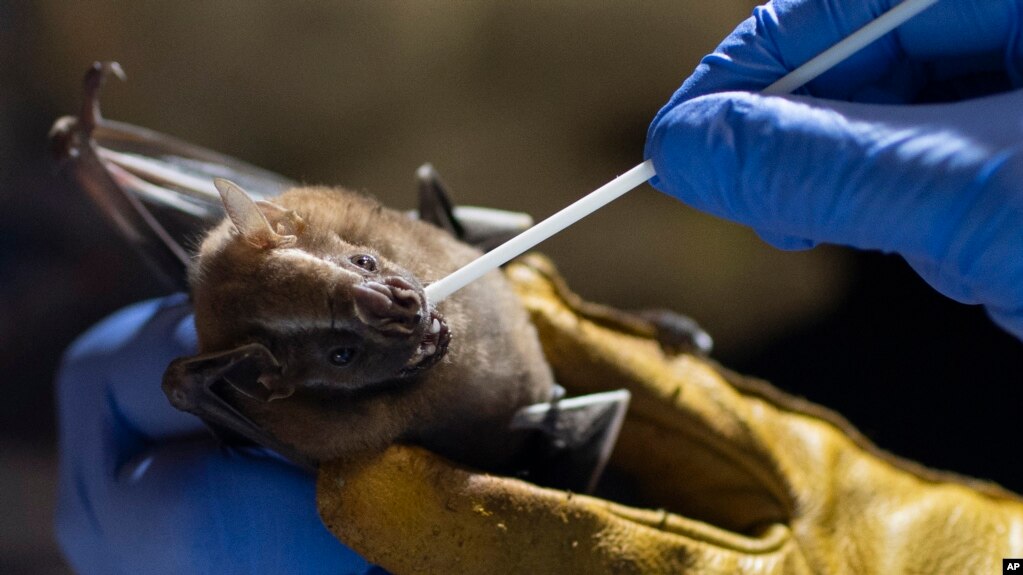マシーン学習が次のコロナウィルス発生地を予測できるかも
先日、コンピューターを使って、いつコロナが発生したかを突き止めるというテレビ番組をみました。研究者によると、月に2回変異を繰り返しているそうです。そこから今の型をさかのぼり、、、2019年10月頃が発生時と割り出していました。
この時期というのは、最初に現実に発生が確認された時期と合致していました。
今日のVOAニュース、驚きの記事ではありますが、上記から考えれば合点のいく研究手段。科学者の終わりなき追究心に敬服するのみです。
英語学習で世界をキャッチ!!
- 機械学習を利用して新しいコロナウイルスが次に発生する可能性のある場所を予測
- Machine Learning Used to Predict Where New Coronaviruses Might Develop Next
- Words in This Story
機械学習を利用して新しいコロナウイルスが次に発生する可能性のある場所を予測
Machine Learning Used to Predict Where New Coronaviruses Might Develop Next
February 17, 2021
研究者たちは、どの動物が人間に影響を与える新しい種類のコロナウイルスを開発する可能性があるかを予測するために、人工知能(AI)の手法を使用しています。
科学者たちは、COVID-19という病気を引き起こす世界中に広がっている新しいコロナウイルスは、コウモリから始まった可能性が高いと考えています。そして、それは人間に感染する前に、別の動物に飛び移ったのです。
新たなパンデミックを防ぐための一つの方法は、専門家が世界の異なる地域のどの動物がコロナウイルスを発症しやすいかを特定することです。この研究に関わった研究者によると、新しいコロナウイルスが発生する方法の一つは、2つの異なるバージョンのウイルスが1つの動物に感染したときに発生するといいます。このような場合、ウイルスの遺伝物質が細胞内で”再結合”したり、混合したりします。これにより、新しいコロナウイルスのバージョンが誕生する可能性があります。
この研究では、コロナウイルスの遺伝的構造に関するデータと、異なる哺乳類に関する情報を調べるコンピュータアルゴリズムが用いられました。アルゴリズムとは、コンピュータのプロセスを完成させるために従う一連のステップのことです。アルゴリズムの中には、AIの一形態である機械学習を動力源とするものもあります。
今回の研究では、動物と人間の両方に感染する可能性のあるコロナウイルスの将来の保菌者となる可能性のある多数の哺乳類が特定しました。研究成果はこのほどNature Communications.誌に掲載されました。
このプロジェクトの主任研究者の一人は、マヤ・ワーデ氏です。彼女はリバプール大学の感染症・獣医・生態科学研究所に所属しています。彼女は声明の中で、これまで、異なる哺乳類が異なるコロナウイルスによってどのように影響を受けるかについては、多くの研究が行われていなかったと述べています。しかし、そのような情報は”ウイルスの組み換えがどこで起こるかについての洞察を提供する可能性がある”とワーデ氏は付け加えています。
機械学習システムは、411種類の異なるコロナウイルスのバージョンと876種類の可能性のある哺乳類を調べました。その目的は、共感染している可能性が最も高く、新しいコロナウイルスを保有している可能性が高い哺乳類を特定することでした。
その結果、哺乳類の種とコロナウイルスのバージョンの間には、過去に特定されたものに比べて約11倍の関連性があることが示唆されました。また、このシステムは、"これまでに観察されているよりも4種類以上の異なる(種類の)コロナウイルスに感染する可能性のある哺乳類の種が40倍以上ある "と予測しました。
マーカス・ブラグローブ氏は、この研究の共同リーダーでした。彼は、研究の結果は、科学者が既に異なるバージョンに発展している新しいコロナウイルスをよりよく理解するのに役立つことができると述べています。
ブラグローブ氏は、コロナウイルスは宿主に感染するとしばしば再結合し、新しいコロナウイルスは人間への感染力が強いことを指摘します。そのため、”公衆衛生に対する最も差し迫った脅威は、他のコロナウイルスとSARS-CoV-2との再結合である”と同氏は述べています。SARS-CoV-2は、新しいコロナウイルスの学名です。
研究チームは、現在のコロナウイルスを見ると、機械学習システムはSARS-CoV-2の組換えが起こりうる宿主を特定したと述べまています。それは、新しいコロナウイルスが発見される可能性がある少なくとも126の非ヒト種を予測しました。
研究では、科学者がコロナウイルスの可能性のある宿主として見ることができるいくつかの特定の種を示しています。その中には、東アジアでは一般的であるが、よく研究されていない少ないアジアの黄色のコウモリと呼ばれるコウモリの種が含まれています。他の種は、一般的なハリネズミ、ヨーロッパのウサギ、家猫です。
科学者たちは、この結果が限られたデータに基づくものであることを認め、この結果を裏付けるためにはさらなる研究が必要であると述べています。しかし、彼らは新しいコロナウイルスのための可能な哺乳類の宿主の最近のテストがシステムの予測の数を確認したことに言及しています。
この結果は、動物から人間へと飛び移る前に、新しいコロナウイルスのバージョンを発見するのに役立つかもしれない、と研究者たちは言っています。次に、彼らは "重要なコロナウイルス宿主の完全な範囲 "をさらに研究するために鳥の種を含むように研究を拡大することを計画しています。
Machine Learning Used to Predict Where New Coronaviruses Might Develop Next
 A researcher for Brazil's state-run Fiocruz Institute takes an oral swab sample from a bat captured in the Atlantic Forest, at Pedra Branca state park, near Rio de Janeiro, Tuesday, Nov. 17, 2020. (AP Photo/Silvia Izquierdo)
A researcher for Brazil's state-run Fiocruz Institute takes an oral swab sample from a bat captured in the Atlantic Forest, at Pedra Branca state park, near Rio de Janeiro, Tuesday, Nov. 17, 2020. (AP Photo/Silvia Izquierdo)
Researchers have used artificial intelligence (AI) methods in an effort to predict which animals might develop new kinds of coronaviruses that affect humans.
Scientists believe the new coronavirus spreading around the world, which causes the disease COVID-19, likely started in bats. It then jumped to another animal before infecting humans.
One way to prevent new pandemics is for experts to identify which animals in different parts of the world are more likely to develop coronaviruses. Researchers involved in the study say one way new coronaviruses form is when two different versions of the virus infect one animal. When this happens, genetic material from the viruses “recombines,” or mixes, in a cell. This can result in a new coronavirus version.
The research involved a computer algorithm that examined data about the genetic structure of coronaviruses and information about different mammals. An algorithm is a set of steps that are followed in order to complete a computer process. Some algorithms are powered by machine learning, a form of AI.
The new study identifies a large number of mammals that could be future carriers of coronaviruses, which can infect both animals and humans. The results of the research were recently published in Nature Communications.
One of the project’s lead researchers was Maya Wardeh. She is with the Institute of Infection, Veterinary and Ecological Sciences at the University of Liverpool. She said in a statement that until now, there has not been a lot of research on how different mammals are affected by different coronaviruses. But, such information “could offer insights into where viral recombination might occur,” Wardeh added.
The machine learning system examined 411 different coronavirus versions and 876 possible mammal species. The goal was to identify the mammals most likely to be co-infected and possibly carry new coronaviruses.
The results suggested there are about 11 times more links between mammal species and coronavirus versions than had been identified in the past. The system also predicted 40 times more mammal species that can be infected “with four or more different (kinds) of coronaviruses than have been observed to date.”
Marcus Blagrove was co-leader of the research. He said results of the study can help scientists better understand the new coronavirus, which has already developed into different versions.
Blagrove noted that coronaviruses often recombine when they infect a host and that the new coronavirus is highly infectious to humans. Therefore, “the most immediate threat to public health is recombination of other coronaviruses with SARS-CoV-2,” he said. SARS-CoV-2 is the scientific name for the new coronavirus.
When looking at the current coronavirus, the team said the machine learning system had identified hosts in which SARS-CoV-2 recombination could happen. It predicted at least 126 non-human species in which the new coronavirus could be found.
The study lists some specific species that scientists can watch as possible hosts for coronaviruses. They include a bat species called the lesser Asiatic yellow bat, which is common in East Asia but not well studied. Others were the common hedgehog, the European rabbit and the house cat.
The scientists admitted the results were based on limited data and said further research is needed to support the findings. However, they noted that recent testing on possible mammal hosts for the new coronavirus had confirmed a number of the system’s predictions.
The results might be used to help discover new coronavirus versions before they jump from animals to humans, the researchers said. Next, they plan to expand their research to include bird species to further study “the full range of important coronavirus hosts.”
____________________________________________________________
Words in This Story
artificial intelligence – n. the power of a machine to copy intelligent human behavior
mammal – n. types of animals that feed milk to its young and that usually have hair or fur covering most of its skin
insight – n. the ability to understand what something is really like
occur – v. to happen
species – n. a group of animals or plants that are similar and can produce young animals or plants; a group of related animals or plants that is smaller than a genus
mutate – v. to cause (a gene) to change and create an unusual characteristic in a plant or animal
host – n. a living organism on or in which a parasite lives
domestic – adj. kept at home as a pet and not in the wild